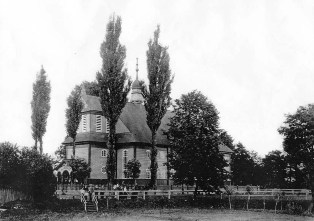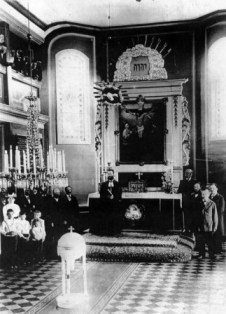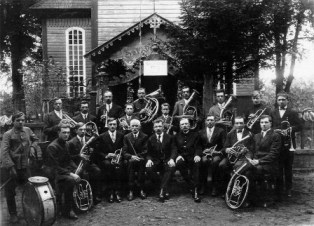
Neudorf Lutheran Parish
Neudorf – Neubrov (after 1928 – Mostitse Dolne – Mostitse Golne) – lutheran parish of settlements on the both banks of the Bug river to the South of Brest (later also in Volyn). Protestant Church in the Neudorf village.
The Neudorf settlement was founded by German speaking community, called “Olendry” (mainly from the Prussian Princedom) in the 2nd half of the XVI century on the lands of Duke Leshchynsky (Leszczynski).
The Perish was founded in 1617. A protestant church
was built, as well as a house for the pastor; the 1st pastor recorded was Jonas
Columbus from Saxony. In 1648 the church and the village were demolished during
the Ukrainian Cossacks. Some 70 Lutherans got killed while being forced to shift
to Orthodox religion. After
Neudorf was ruined there was only a chapel left whereas the community belonged
to churches in Peski near Lublin, since the end of the XVIII c. – under the
supervision of Wengrov pastors.
In 1670 Duke Leshchynsky gave Neudorf some 45 morgues of land to be kept by the pastor. The construction of the new Church being banned by the Catholic authorities in 1690 – 1694, Duchess Prazmovska (Praźmowska) financed the construction of a new Chapel i Nuedorf, explaining it as a reconstruction. In 1709 and 1712 the financial supervisor of the church was the Great Lithuanian Princedom Chancellor Karl Stanislav Radzivill.
In 1776 the 1st printed edition of the church
history was published under the title «Historia ecclesiae Neoburchdorffensis
alias Slavatycensis». In 1777 – 78 with the assistance of Karl Radzivill a new
church was built. (St. Trinity – consecrated in 11/15/1778). In XVIII Lutheran
communities of Lublin, Peskov, Zamostye and Kamenets POdolski found themselves
under the spiritual patronage of Neudorf pastors (who bore the status of Lublin
pastors and Neudorf plebans ); the pastorate kept joining to Lublin until 1791.
In spite of the initial connection with the Crown Lutherans, the Neudorf church
entered the jurisdiction of the Lutheran church of the Great Lithuanian
Princedom of Vilnya consistory. The decision of the Lutheran Synod of the Great
Lithuanian Princedom in BIrzha 1784 – Neudorf got included into the Slutsk
Lutheran church district; 10/8/1793 – the sentence of the spiritual court of the
Lutheran Consistory, due to internal riots, imposed a church redemption on the
whole perish.
Since 1832 Neudorf is under the supervision of the Kurland cosistory; in 1858 –
the Lutheran community of Brest was acknowledged as a subsidiary of the Neudorf
church community.
|
The outside view of the Neudorf church. The beginning of XX century picture. |
Historical Altar of the Neudorf Church. 1902. |
Church orchestra of the Neudorf perish. 1928 picture. |
The Polish language replaced German in the church practice of Neudorf in the 1st half of the XVIII century. A well-known edition «Postilla Chrześćjiańska» was used written by S.Dombrovsky, as well as «Kancyonał Pruski» and some other Polish language Lutheran editions of Eastern Prussia, Silesia, Baltic Sea region. Due to shortage of pastors in Kurland consistory, who were able to exercise divine services in Polish, in XIX century the church didn’t have its own clergy or they were invited from the Polish Kingdom. The attempts of the authorities in XIX – the beginning of XX centuries to introduce German in Neudorf turned out to be unsuccessful. As an everyday language “OLenders” were known to use the so-called “Western Boug dialect”.
Due to lack of land the part of Lutherans-“Olenders” of Neudorf in the beginning of the XX century moved to Syberia and Ural. In 1911 the Neudorf perish counted some 4000 persons; after the I World War – as a part of Evangelical – Augsburg church of Poland. In 1928 – Neudorf was renamed to “Mostitse” (Mościce). In 1939 Neudorf found itself within the border territory on the Soviet side. The population had to leave the settlement and move to Germany or farther deep to the USSR, in 1941 the Church building got destroyed for good.
After the 2nd World War the former Neudorf perish believers could be found to leave in Germany, Poland, and some of them in the Belarusian Soviet socialistic Republic.
→ See the location of the church on the map, 51.753417, 23.578750
Sources:
Schultz, E. H. Kronika zboru ewangelicko-luterskiego Nejdorfskiego. “Zwiastun Ewangeliczny”, 1902.
Kneifel, E. Die Evangelisch-Augsburgischen Gemeinden in Polen, 1555-1939. Eine Parochialgeschichte in Einzeldarstellungen. Vierkirchen, Selbstverlag [1972].
The pictures are from the Archive of the Warsaw Lutheran Consistory.
(ñ) Nikolay Pachkayev, 2005
Date of publication: 2008
The Article was prepared for the
project “The Encyclopedia of the Great Lithuanian Princedom”, where, by mistake,
it was published with some misleading “corrections”. This is an original
version. Printed with the author’s permission.
Translated by V. Danish
When copying, be sure to indicate the author. Use for other purposes is permitted only with the consent of the author.
When any information of the site is used, a hyperlink to the site is a must
Created and designed by © Prokopiuk I. (2008-2022)


